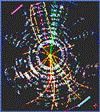Department of Physics and Astronomy: Individual Faculty Pages

Kenneth Bloom Publications
Document Type
Article
Date of this Version
5-5-2005
Abstract
We have measured the azimuthal angular correlation of b[overline b] production, using 86.5 pb-1 of data collected by Collider Detector at Fermilab (CDF) in pp̅ collisions at sqrt(s)=1.8 TeV during 1994–1995. In high-energy pp̅ collisions, such as at the Tevatron, bb̅ production can be schematically categorized into three mechanisms. The leading-order (LO) process is "flavor creation," where both bb and b̅ quarks substantially participate in the hard scattering and result in a distinct back-to-back signal in final state. The "flavor excitation" and the "gluon splitting" processes, which appear at next-leading-order (NLO), are known to make a comparable contribution to total bb̅ cross section, while providing very different opening angle distributions from the LO process. An azimuthal opening angle between bottom and antibottom, Δф, has been used for the correlation measurement to probe the interaction creating bb̅ pairs. The Δф distribution has been obtained from two different methods. One method measures the Δф between bottom hadrons using events with two reconstructed secondary vertex tags. The other method uses bb̅-->(J/ψX)( ℓ X′) events, where the charged lepton (ℓ) is an electron (e) or a muon (µ), to measure Δф between bottom quarks. The bb̅ purity is determined as a function of Δф by fitting the decay length of the J/ψ and the impact parameter of the ℓ. Both methods quantify the contribution from higher-order production mechanisms by the fraction of the bb̅ pairs produced in the same azimuthal hemisphere, ftoward. The measured ftoward values are consistent with both parton shower Monte Carlo and NLO QCD predictions.


Comments
Published by American Physical Society. Phys. Rev. D 71, 092001 (2005). http://prd.aps.org/. Copyright © 2005 American Physical Society. Permission to use.